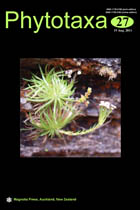Abstract
In a coastal plain forest in eastern Texas, USA, occurs a population of a putative Sabal hybrid, one of few native, putative palm hybrids in the continental USA. Robust plants with large trunks, they are morphologically dissimilar to the much smaller and acaulescent plants of S. minor, with which they co-occur. The only other large Sabal species in the USA are S. mexicana and S. palmetto, with S. mexicana native only to Texas. Using Amplified Fragment Length Polymorphisms (AFLPs), we sampled several plants of the putative hybrid and its possible parents in order to evaluate its possible hybrid origin. UPGMA, principal coordinate analysis, and Bayesian analyses indicated that it seems to be a hybrid, but an old one, with clear genetic distinctiveness. However, these results also suggest a closer affinity of the putative hybrid with S. minor and S. palmetto than with S. mexicana, excluding the latter species from possible parentage. Results also suggest that S. minor, despite its wide morphological diversity, is a clearly coherent species with minimal evidence of introgression, except for Mexican material that appears to be introgressed with S. mexicana. Sabal palmetto may also possess a complicated genetic history not necessarily reflected in its morphology.

